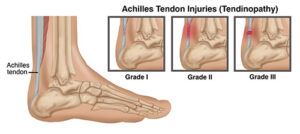What is Tendinopathy?
Have you or anyone you’ve known been diagnosed with tendinopathy? Tendinopathy refers to a break down of the collagen fibers of a tendon and can occur in any muscle tendon of the body. This condition can be caused by a single event or continuous irritation to the tendon, creating a micro-trauma over time. Tendinopathies typically result from a demand placed on the tendon that is greater than its current strength. It can impact both men and women at various activity levels, although more common in male athletes, especially runners. Symptoms typically present when the irritated muscle is activated and often improve with rest. With the pandemic, many people have turned to walking and running outdoors for their exercise, which has resulted in an increasing frequency of Achilles tendinopathy.
The Achilles tendon is a thick band of tissue on the back side of the lower leg that connects the calf muscles to the heel. This tendon is responsible for transferring forces between the calf and ankle to propel a person forward, off of the ground (i.e. walking & running) and then controlling the ankle’s landing when the foot returns to the ground.
Achilles Tendinopathy Symptoms
• Increased heel pain while walking, running, jumping etc.
• Calf muscle weakness or tightness
• Swelling of the tendon area
• Tenderness behind the heel along the tendon
 Achilles Tendinopathy Treatment
Achilles Tendinopathy Treatment
Eccentric exercises are effective for treating tendinopathy. You might be asking what is an eccentric based exercise? Eccentric exercises focus on strengthening the muscle in a lengthened position. It is suggested that this technique facilitates remodeling of the tendon by putting less strain on the tendon while active, resulting in hypertrophy and increased tensile strength.
Alfredson et al., implemented an eccentric training program, which consists of two exercises performed 2 times a day, 7 days a week for 12 weeks. Exercises should be performed as 3 sets of 15 reps and are to be performed through pain, unless pain levels become debilitating. Once able to perform without any pain or discomfort, you can progress each exercise by adding weight.
Studies investigating the effect of this program remain positive and results suggest a safe model for improving calf integrity and strength. Pain levels reduced over a 6-12 week period and an increase of satisfaction in patient participation. Two demonstrations of these exercises, with advanced options, are as follows:
Exercise 1: Heel raises performed with knee straight; push up on balls of feet and slowly lower down with the involved foot
Exercise 2: Heel raises performed with the knee bent; push up on balls of feet and slowly lower down with the involved foot
Exercise 3: Advanced heel raises performed on a 4-6 inch box or step with knee straight; push up on balls of feet and slowly lower down with the involved foot
Exercise 4: Advanced heel raises performed on a 4-6 inch box or step with the knee bent; push up on balls of feet and slowly lower down with the involved foot
Keep in mind, this is only one approach to rehabilitation. Although there is strong evidence with performance of eccentric based exercises, the rehab process can be complimented with physical therapy services, such as, manual therapy treatments to improve tissue mobility, various styles of exercise to challenge a muscle within a pain-free range and application of physical modalities (i.e. K-laser to reduce inflammation). You can even check out our last post on Foot Core to help with Achilles tendinopathy.
If symptoms persist, or worsen with exercise, discontinue irritating exercises and make an appointment with a physical therapist for a full evaluation and comprehensive plan of care.

